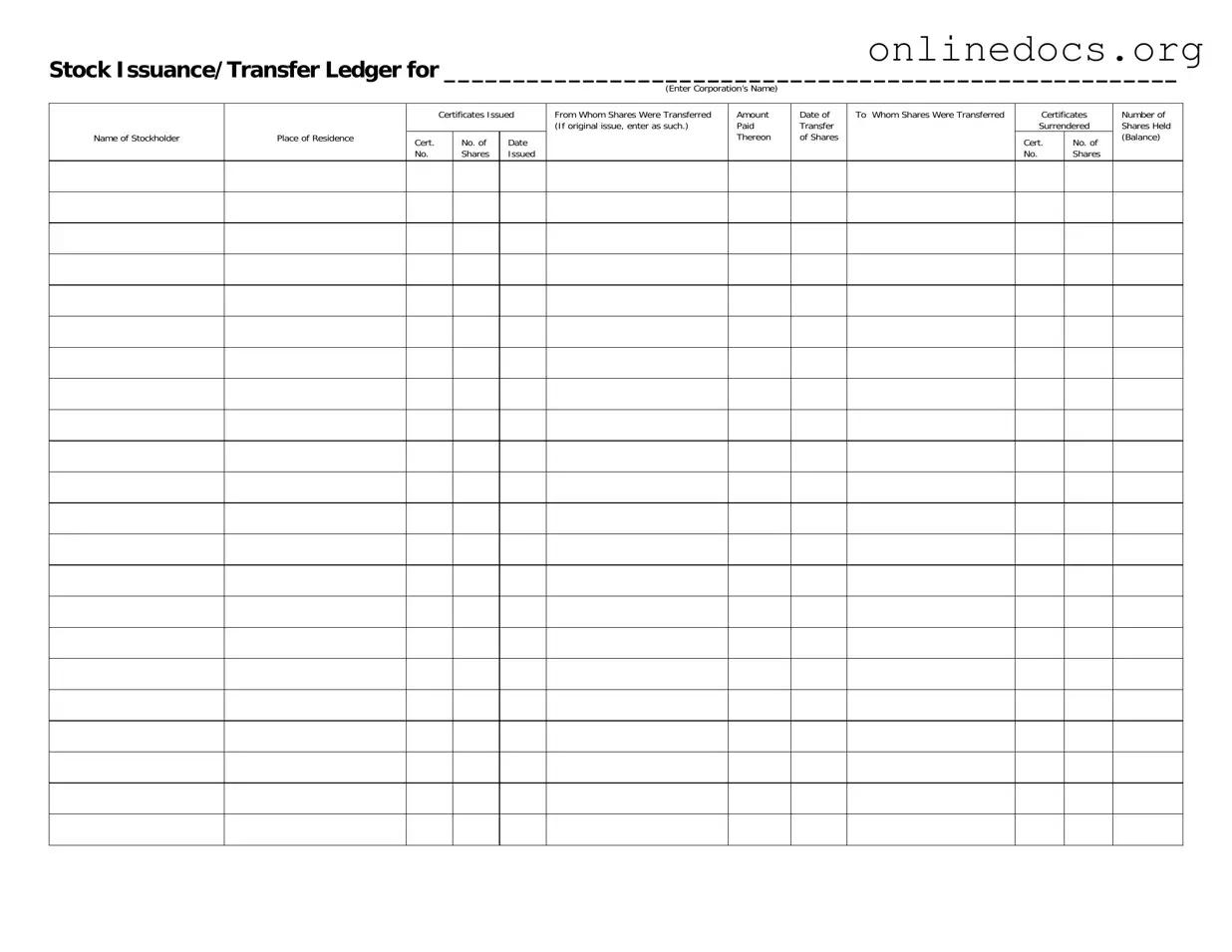The Stock Transfer Ledger form is similar to a Shareholder Register. A Shareholder Register is a comprehensive list of all shareholders in a corporation, detailing their names, addresses, and the number of shares they own. This document serves as the official record of ownership, much like the Stock Transfer Ledger, which tracks the issuance and transfer of shares. Both documents ensure accurate record-keeping for the corporation and help verify ownership when needed.
Another comparable document is the Certificate of Stock. This certificate serves as tangible proof of ownership of shares in a corporation. While the Stock Transfer Ledger records the transactions related to shares, the Certificate of Stock is issued to the shareholder as evidence of their ownership. Both documents play crucial roles in establishing and maintaining clear ownership records within a corporation.
The Stock Option Agreement is also similar in that it outlines the terms under which an employee can purchase shares of stock in the company. While the Stock Transfer Ledger focuses on the actual transfer of shares, the Stock Option Agreement details the conditions and rights associated with acquiring those shares. Both documents are essential for managing equity ownership and ensuring that all parties understand their rights and obligations.
A Texas Quitclaim Deed form is a legal document used to transfer interest in real property from one person to another without any warranties of title. This means that the seller, known as the grantor, does not guarantee they hold clear title to the property. It's a common tool for transactions among family members or to quickly change names on a property title. For more detailed information, you can visit legalformspdf.com.
A Subscription Agreement is another document that shares similarities with the Stock Transfer Ledger. This agreement outlines the terms under which an investor agrees to purchase shares from a corporation. While the Stock Transfer Ledger records the actual transfer of shares, the Subscription Agreement lays the groundwork for that transfer by establishing the terms and conditions of the purchase. Both documents are vital for tracking ownership and maintaining accurate records.
The Corporate Bylaws also bear resemblance to the Stock Transfer Ledger. Bylaws govern the internal operations of a corporation, including how shares are issued and transferred. While the Stock Transfer Ledger specifically tracks these transactions, the Bylaws provide the framework within which these transactions occur. Both documents are essential for ensuring compliance with corporate governance and ownership regulations.
The Annual Report is another document that parallels the Stock Transfer Ledger. An Annual Report provides a summary of a corporation’s financial performance and operations over the past year, including information about stock transactions. While the Stock Transfer Ledger focuses on individual share transfers, the Annual Report offers a broader view of the company’s overall stock activity, helping stakeholders understand the company’s health and performance.
The Stockholder Agreement shares similarities as well. This agreement outlines the rights and responsibilities of shareholders, including how shares may be transferred. While the Stock Transfer Ledger records the actual transfer of shares, the Stockholder Agreement sets the rules governing those transfers. Both documents are crucial for maintaining orderly and transparent ownership within the corporation.
The Dividend Declaration is another document that relates to the Stock Transfer Ledger. When a corporation decides to distribute profits to shareholders, it issues a Dividend Declaration. While the Stock Transfer Ledger tracks the ownership of shares, the Dividend Declaration communicates to shareholders their entitlement to dividends based on the number of shares they own. Both documents are important for ensuring that shareholders receive their fair share of the company’s profits.
Lastly, the Form 10-K, which is an annual report filed with the SEC, is similar to the Stock Transfer Ledger. This form provides a comprehensive overview of a company’s financial condition, including information about stock transactions and shareholder equity. While the Stock Transfer Ledger tracks individual share transfers, the Form 10-K offers a broader perspective on the company’s overall stock performance. Both documents are essential for transparency and accountability in corporate governance.
